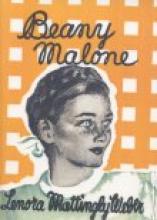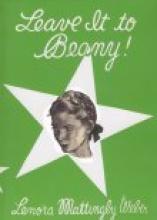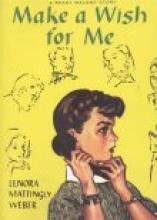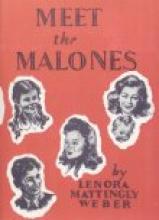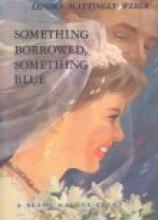No name
Beany Malone
Number of pages:
186 pages
Copyright:
1948
Publisher:
Image Cascade Publishing
Binding:
Softcover
Subject(s):
Grade / Age level:
Review:
In this second book of the series, 16 year old Beany struggles with the tendency of her family to "stick their necks out" for others at the risk of disappointment, emotional stress and failure. Johnny is busy trying to help an older, forgetful man write a book he's always wanted to write, but may not live to finish. Mary Fred is struggling with the fickle sorority girls in college and Elizabeth anxiously awaits her husband's return from the war. Beany sees a role model in her friend's mother who never lets herself worry about anything and enjoys a carefree life (which her own daughter detests). Beany begins to close herself to new friendships and other things that might make life "too difficult." Beany thinks this is a great idea until the mother's childish behavior betrays her and Beany learns to see things in a new light with the help of her family's attitudes in the face of difficulty.
Reviewed by:
First reviewed:
3-13-02
Come Back Wherever You Are
Subject(s):
Grade / Age level:
Review:
Beany, now married with two children, struggles to help Kay's young son who is having emotional difficulties.
First reviewed:
2/18/06
Happy Birthday, Dear Beany
Subject(s):
Grade / Age level:
Review:
Beany is delighted when she hears that her dear childhood friend Miggs Carmody has moved back to Denver, but when they meet up again there is a strange wall between them. Is it because Miggs' family has become very wealthy? There is a scene in which a boyfriend shakes Beany and hurts her. It might be important to talk to your daughter about this scene and how wrong the boyfriend is no matter what Beany's faults in the situation were.
First reviewed:
2/18/06
Leave it to Beany
Subject(s):
Grade / Age level:
Review:
Fifteen year old Beany is a practical and competent high school sophomore. She knows just how to make the grocery budget stretch just right. She looks out for ways of making people feel more comfortable. From the moment she heard about her long lost cousin, 18 year old Sheila McBride, she pictured a desolate and helpless soul needing a mother hen to make her feel welcome and give her an easier time of things after the difficult life she's led. But from the moment Sheila arrives, everything seems to go wrong. Sheila isn't very talkative and is fond of her gaudy clothes. Beany worries that she just won't fit in if she doesn't dress differently. After not hitting it off very well with the Malones, Sheila decides to strike out on her own. Meanwhile, the well-meaning Beany has become assistant to a newspaper advice-columnist and gets personally involved in one of the letter-writers - who leaves Beany with a baby to take care of! Johnny works desperately to get Emerson Worth's historical manuscript finished so that his accomplishments will be recognized before he dies. The much-coveted Golden Spur award is won - but only after the elderly gentleman's death. Beany is still dating the insecure and tempermental Norbett Rhodes. Frustration mounts because Beany and Norbett have a major misunderstanding. This engaging story highlights some of the wisdom teenagers have not yet acquired through the eyes of the "wise ones" in the story - Martie Malone (their father), Eve Baxter (the advice columnist) and Emerson Worth.
Reviewed by:
First reviewed:
4-3-02
Make a Wish for Me
Subject(s):
Grade / Age level:
Review:
Beany now sixteen, is a junior and busy with the school paper. More than anything else she wants the editor to pick her to go the school paper convention. Norbett Rhodes has moved to Ohio and suggested that Beany could date others. Devastated at first, Beany has made friends with Andy Kern who thoughtfully likes to keep things light (in the dating department). After promising her nice mother, Beany reluctantly befriends a new girl at school, Dulcie, who is a showoff and very flirtatious with the boys. Dulcie soon makes enemies with lots of the girls in school - including the editor of the paper. Beany is caught between a rock and a hard place because, while disapproving of Dulcie's behavior, she sees that underneath the tough exterior, Dulcie is a insecure girl without the benefit of the supportive family Beany has been blessed with. Meanwhile, Norbett Rhodes shows up, mysteriously seeking Beany's help. Martie Malone and his new wife are understanding through all of these escapades, but definitely not clueless. In the end intregrity wins out over trying to be popular for Beany and Dulcie's flirtatious ways cause her to lose the friendship of the one boy she really cared about. This story more seriously tackles issues about dating than the previous books do - especially the dangers of "going steady". The author subtlely (and at times not-so-subtlely) encourages good friendships and fun double-dating in the high school years rather than intense romantic relationships.
Additional notes:
This book was donated for review by Image Cascade
Reviewed by:
First reviewed:
4-3-02
Meet the Malones
Subject(s):
Grade / Age level:
Review:
This is a charming and engaging story of a Catholic family living in Denver during World War II. The Malones - Beany (13), Johnny (15), Mary Fred (16) and Elizabeth (19) lost their mother several years before the story begins. Their father, Martie, is a respected newspaperman whose column is often assigned reading in the local schools. Mr. Malone is a loving father who frankly explains to his children that he's glad he doesn't have the means to spoil them, as he knows it's better for them to take initiative and responsibility for themselves. This first story focuses on Mary Fred and her adventures as a high school junior and the owner of a new horse. Mary Fred, Johnny and Beany all want to earn money for some pet projects, as so they decide to share the chores of cooking and cleaning rather than hire a new maid when "Mrs. no-complaint Adams" quits. When Mr. Malone is called away to Hawaii for several months, their grandmother Nonna, a fashionable interior-decorator, arrives with lots of nice things for the children...and her own ideas about how the family should live. Meanwhile, the most popular boy in school takes a sudden interest in Mary Fred. When Father sends three orphan children for the Malones to care for and Nonna wants to send them to an orphanage, some important decisions have to be made. Mary Fred eventually comes to a greater appreciation for her family and the things that matter most.
Reviewed by:
First reviewed:
3-13-02
Pick a New Dream
Subject(s):
Grade / Age level:
Review:
Beany is disappointed in a newspaper job falling through and begins work at the Community Center with Carlton Buell.
First reviewed:
2/18/06
Something Borrowed, Something Blue
Subject(s):
Grade / Age level:
Review:
Beany is offered the dream wedding by her step-grandmother who is a fashionable wedding consultant. Tempers flare and personalities clash as these dreams conflict with other, more important things.
First reviewed:
2/18/06
Tarry Awhile
Subject(s):
Grade / Age level:
Review:
Beany has a long engagement and is jealous of friends who marry quickly and hassle her about it.
First reviewed:
2/18/06

